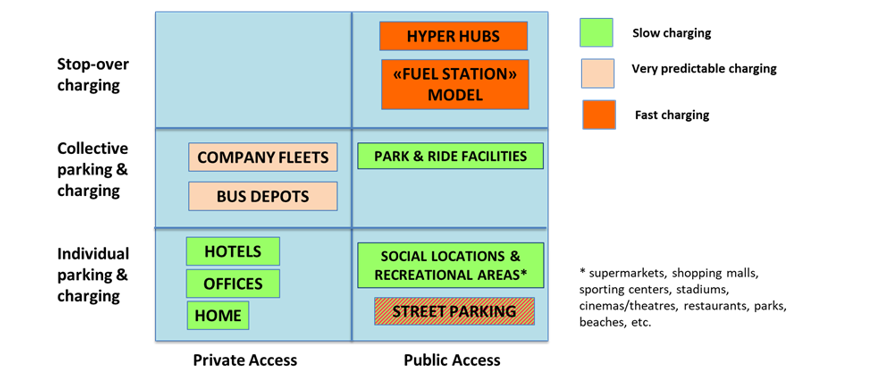The interaction of electromobility with the power grids
The paper summarizes the views of 5 distinguished experts, that were presented at the Special Panel Session entitled "The interaction of electromobility with the power grids", organized by ETIP SNET at the CIGRE Paris Session in Paris, on 2nd September 2022. European Technology & Innovation Platforms (ETIPs) have been created by the European Commission in the framework of the new Integrated Roadmap Strategic Energy Technology Plan (SET Plan) by bringing together a multitude of stakeholders and experts from the energy sector. The ETIP Smart Networks for Energy Transition (SNET) role is to guide Research, Development & Innovation (RD&I) to support Europe’s energy transition. It prepares Visions (2050), Roadmaps (10-year horizon) and Implementation Plans (rolling, 3–4-year horizon) and coordinates with other initiatives at national and European level.

by Antonio Iliceto, Santiago Gallego, Joao Abel Peças Lopes, Luis Lopez, Ning Zhang, Nikos Hatziargyriou
Introduction
The transportation sector is responsible globally for around 25% of the total greenhouse gas (GHG) emissions. As a result, international policies have set specific strategies for a cleaner transportation sector; e.g., the EU 2030 Climate Target Plan set the ambitious target to reduce GHG emissions by 55% by 2030 (compared to 1990 values), and imposed this reduction on all transportation sectors (road, aviation, naval). Such goals have led to a significant increase in Electric Vehicles (EVs) and the higher availability of EV-charging options. The deployment of a large number of EV chargers will significantly increase the load of the network, and uncontrolled charging of EVs could provoke significant issues for the grid, which would require major infrastructure reinforcements. Smart charging and Vehicle-to-Grid (V2G) approaches can mitigate these impacts and, moreover, exploit the flexibility potential of these new loads for better use of RES and more efficient planning and operation of the energy system.
In the paper the views of CIGRE, ETIP SNET, IEA and other organizations, as expressed by their representatives are provided and key messages are highlighted.
The EV Charging Infrastructure as a Win-Win Solution for Sector Integration
Antonio Iliceto (TERNA, Co-Chair of ETIP SNET WG 1 and Chair of CIGRE SC C1)
ENTSO-E (European TSOs association) in its Position Paper [1] considers electromobility is a powerful resource, not only to decarbonise the transport sector but also to provide flexibility services to the energy system. An optimal vehicle-grid interaction will guarantee important environmental and economic benefits for consumers and for all involved actors, as well as improved system management. To make it real, all the involved actors should cooperate to promote the adoption of smart charging and vehicle-to-grid (V2G) technologies, which allow also the inception of new digitalised services to the EV drivers, from the beginning of deployment of charging points. The number of commercially available models is rapidly increasing, and typical users’ concerns when comparing them to internal combustion engine (ICE) vehicles, such as short-range autonomy and higher purchase prices, are expected to be solved shortly. The major gap to be covered is the development of a suitable charging infrastructure answering the needs of different stakeholders in the electro-mobility value chain.
EV charging process represents the concrete interface between transport and energy sectors and is the crucial element for guaranteeing the successful development for both. According to the analysed charging use-cases (Fig. 1), leaving the charging process uncontrolled can result in significant challenges for the power system, such as peak power demand due to cumulative effects in certain time-periods. In contrast, managing the charging process in terms of time scheduling and power profile will not only limit the potential challenges but also open new opportunities.
Technical and connectivity solutions enabling a new ecosystem centered around consumer expectations together with supportive regulation and market schemes, shall be adopted through the constructive cooperation of charging operators with grid operators, transport, urban planning, vehicle industry stakeholders and decision makers. TSOs and DSOs shall promote coordinated planning for charging infrastructure and electric grid through scenario definition, improved modelling and considering the diffusion of “hypercharger hubs” on highways. The time for action is now, before mass EV deployment, to avoid the need of the future “retrofitting” of non-smart chargers. The positive effects will be relevant and shared among all citizens, who are the final users of both energy and mobility services and who will benefit from cleaner transport and stronger energy systems.

Figure 1 - EV charging use cases, structured according to access, parking characteristics and charging time (Source: ENTSO-E)
Electromobility and impact on grids: ETIP SNET perspective
Santiago Gallego Amores (i-DE (Iberdrola) Regulation Manager, Co-chair of ETIP SNET WG1)
Electromobility remains the best solution to achieve the climate and industrial ambition of the European Green Deal for transport, ensuring a clear pathway towards zero-emission mobility. Nevertheless, the electrification of transport will create new loads with specific profiles, challenging the capability of system operators to manage additional volumes of electricity while ensuring the required level of security of supply for all types of network users. At the same time, electromobility can offer a new flexibility resource for both market players and system operators. It is in the context of this new ecosystem that the European Technology & Innovation Platform (ETIP) Smart Networks for Energy Transition (SNET) has triggered the technical debate on the ability of SOs to play a major role in facilitating the development of an electrified mobility.
The main conclusion of its work is that a proper ecosystem, directly involving EV users, charging operators, manufacturers, service providers, decision makers and research bodies, is needed to allow the optimal exploitation of electric vehicles and to implement the opportunities they can offer to electricity networks. It is equally important to propose new electromobility policies and strategies fostering a more coordinated planning and updating the current regulation that still limits the possibilities offered by smart charging and V2G technologies. The analysis of use cases has shown that the implementation of smart grids and the utilization of data analytics can help identify necessary reinforcements in areas of the network where the electric mobility load is expected to grow faster. Smart management of the charging process can also significantly reduce network investments in mass adoption scenarios. In this sense, the users perspective and their charging behaviours are definitely crucial to understand the future scenarios that the integration of electromobility will bring to the electricity system.
Electromobility and flexibility
Joao Abel Peças Lopes (Prof at FEUP and Director of INESC Porto, Convenor of CIGRE WG C6.40)
Distribution power grids have evolved in complexity over recent years due to the rise of the presence of distributed renewable energy sources and due to considerable increase in consumption because of the energy transition. The electric vehicle (EV) fleet is rapidly expanding, which brings a new important load into the grid. Due the time variability of the renewable power sources, electrical grids require flexibility to deal with planning and operation. Electric vehicle are important sources of flexibility either the in V1G (vehicle-on-grid / smart charge) or V2G (vehicle-to-grid) modes. EVs equipped with V2G capability can use their batteries to provide power to the grid. The possibility to modulate the charging in the V1G mode allows to cope with several grid constraints and allows to avoid possible curtailments of renewable generation.
EV control will progress by steps in the coming years. Currently EVs can be considered mostly as a load (Stage 1). With smart charging strategies EVs could act as controllable loads (Stage 2). In the future EVs may integrate V2G capabilities (Stage 3), acting as generators. In the first stage, networks can use tariff designs that encourage off-peak charging. Stage 2 and 3 require more complex communications and control equipment and market mechanisms to deal with Distribution Systems Operator needs as well as for the provision of ancillary services by EVs.
With appropriate control, EVs can also help in controlling voltage problems in the low voltage network, converting EVs into a voltage supporting instrument. In this case the EV converter is also capable to inject reactive power in the grid and, in this way, help in voltage control. New actors, like the aggregators, will also emerge to support the provision of the ancillary services by EVs to System Operators. The controllability of EV converters can contribute to support islanding operation of distribution grids and support black start bottom-up procedures. Regulators should encourage new designs for EV charging equipment to be capable of providing both active and reactive power support operating power converters in the 4 quadrants.
Role of Public Authorities in Deploying Public Charging Infrastructure and Ensuring Integration of EV Charging into the Grid
Luis Lopez (Energy Analyst at International Energy Agency (IEA) Global E-mobility Programme)
The IEA focused on the role of public authorities in deploying public charging infrastructure and ensuring integration of EV charging into the grid. These findings presented are developed in the context of the GEF-funded programme to support countries in their shift towards electric mobility, in which the IEA coordinates a global thematic working group on "EV charging and grid integration, renewable power supply, and batteries” [2].
To support EV growth and capture the opportunities EV charging represents for the power sector, the main recommendations to public authorities are the following:
- Showcase the deployment of EVs and EV charging as a political priority to attract investment and reassure prospective EV users that measures are being taken to address range anxiety.
- Break down silos between sectors and adapt planning to accommodate the full value of EVs. Conduct integrated and coordinated planning at different levels among transport, power, buildings, and municipalities to effectively deploy charging infrastructure and anticipate grid upgrades. Revisit planning criteria to allow alternatives to grid expansion and resource adequacy to accommodate distributed resources such as flexible EV charging. Ensure that total system costs are considered in planning decisions to highlight operational savings from smart charging.
- Tailor your strategy. Identify the charging needs and charging power based on local mobility patterns and characteristics while, at the same time, encouraging modal shift. Create mobility scenarios to support power system planning.
- Encourage standardisation and ensure interoperability. Reduce costs of electromobility through cooperation with industry by standardising EV charging components. Facilitating interoperability not only benefits the EV user and the reliability of finding a charging point, it also helps aggregate more EVs for power system participation.
- Future-proof your infrastructure. Build progressive targets into planning which incorporate minimum levels of smartness to leverage the flexibility of EVs.
- Coordinate EV and wind and solar power deployment to accelerate decarbonisation. Accelerate EV uptake to take advantage of technologies driven by distributed energy resources. Deploy charging in locations where distributed renewables are already available or where they could be cost-effective to increase consumption of clean electricity. Facilitate access to wholesale markets to take advantage of synergies with utility-scale renewables.
- Value the services that EV can provide to the system. Create an environment to incentivise the use of EV flexibility through designing dynamic electricity tariffs, creating contracts or markets for flexibility, or allowing aggregator participation in wholesale and balancing markets.
The Growing EV impact on power systems
Ning Zhang (Assoc. Professor at Tsinghua University, Convenor of CIGRE WG C1.47)
The rapidly rising charging demand of EVs will have an increasing impact on both transmission level and distribution level of power systems. Such impact mainly reflects in three aspects: load demand, voltage stability, power quality.
- The fast charging at peak hours increases peak demands and may violate system operation limits such as transformers and cables overload. Large integration of uncontrolled EVs charging leads to higher system uncertainties. On the other hand, delayed charging, controlled charging, V2G shift charging to off-peak hours. EVs can even be utilized to provide frequency regulation.
- The disorder charging will lead to voltage drop and increase the phase unbalance. While order charging and V2G can regulate voltage by controlling the active and reactive power demand. EV bidirectional chargers can supply reactive power as well.
- The EV chargers inject harmonics into the grid and increase system loss, which decreases power quality and component's life cycle. The controlled EV charging also reduces voltage unbalance. Properly designed power electronics circuits can filter harmonics.
In China, the number of EVs has increased from 80,000 in 2014 to 6.40 million in 2021, accounting for 2.1% of the overall vehicles. The charging piles and electricity demand of EVs are also rising rapidly. The public charging piles reach 1.58 million by June 2022. For Beijing city, the total number of charging piles would reach 0.70 million in 2025, which has a total capacity that is larger than the current overall peak load of Beijing. China is expected to have 300 million EVs by 2040. The EV battery capacity will exceed 20 billion kWh, which is equal to the total electricity consumption in China per day in 2021.
Banner & thumbnail credit: DKosig on iStock

